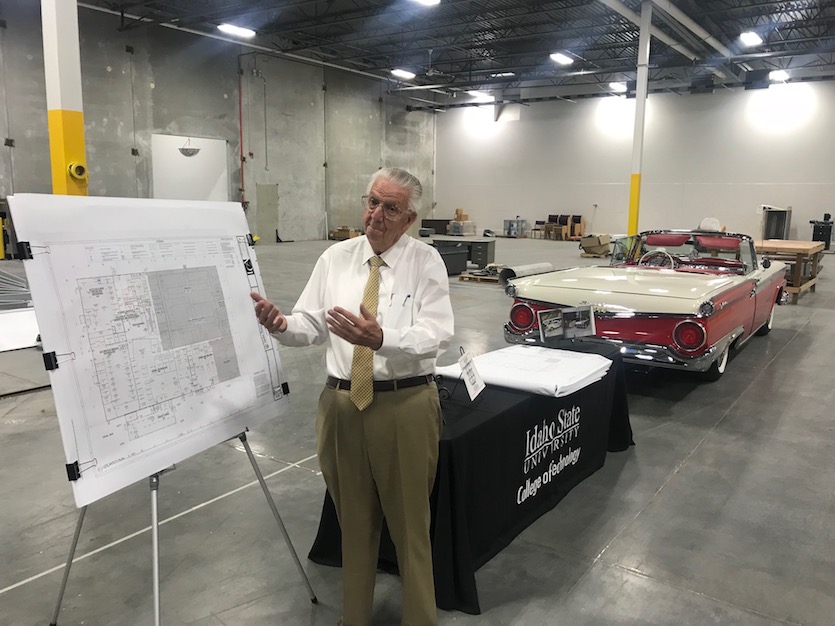'Lunch and Learn' tour shows off Eames Advanced Technical Education and Innovation Complex facilities
May 25, 2018

Community members, local decision-makers, media representatives and Idaho State University faculty and staff visited the William M. and Karin A. Eames Advanced Technical Education and Innovation Complex on May 22 to tour newly renovated research laboratories and technology classrooms.
The tours were led by William Eames, an alum of the ISU College of Pharmacy who is a $2.5 million benefactor for the complex, and Cornelis Van der Schyf, ISU vice president for research and dean of the Graduate School. Participants stopped at various laboratories and classrooms where they received updates from ISU faculty and staff.
The 216,000-square-foot facility will be about 75 percent occupied by College of Technology programs and the rest of the space will be devoted to research laboratories and office spaces. A $22-million project to finish the renovation of the building will begin in August with a tentative completion date of August 2019.
“One of things we want to do with this facility is to make the case that the College of Technology programs of today are different than the College of Technology Programs of yesterday,” said Laura Woodworth-Ney, ISU executive vice president and provost. “These are rigorous, technology-based programs. Our students are sometimes getting job offers before they graduate and they’re changing the economy of Southeast Idaho and of the region.”
She also said ISU is unusual in the number of degrees and programs it offers, from associate to doctoral degrees and the building is a good fit for College of Technology students and academic researchers to work together. She gave the example of students in the College of Technology’s unmanned aerial systems program working with ISU geosciences researchers in the field.
“We want that kind of work to expand here in this facility,” Woodworth-Ney said. “That will be unique nationwide. We have that ability because we have all these programs on site here.”
Before leading his portion of the tour, Eames recounted College of Technology student success stories at businesses and companies from throughout the region, including those working at Industrial Metal Enterprises in Blackfoot, Spudnik Equipment Company in Idaho Falls, Schweitzer Engineering Laboratories in Lewiston, Monsanto in Soda Springs, and Western States CAT in Pocatello, as well as gold mines in Nevada and large dairy operations in Twin Falls. He referred to outstanding graduates of the school “which all of you living here can be proud of taking part in, one way or another.”
“I will be walking through with some of you and explaining where I think we are going with the College of Technology and how we are developing young people to work in their chosen career and help all of us in Southeast Idaho,” Eames said.
Toured areas included the machining and Computer Aided Design areas that have already been moved to the new building from the College of Technology, and the Center for Archaeology, Materials and Applied Spectroscopy (CAMAS) research laboratory that is being moved to the building.
“This is kind of a really premier laboratory,” said John Dudgeon, anthropology assistant professor and research scientist referring to CAMAS. “It turned out really well. I’ve been to several labs like this in the country and this is every bit the equivalent of the ones I’ve been in other locations. What is nice about this lab is that it allows us, by being in this building to do forensic analysis. It allows us to produce best quality data and information.”
CAMAS is organized in three parts as a biomolecule laboratory, as an imaging and micro analysis facility and an elementary isotopic analysis facility, Dudgeon said.
“This facility (Eames Complex) allows a student from the College of Technology to come together with graduate students up to the Ph.D. level,” Van der Schyf said. “If you talk to people in industry or in national labs and ask them what workforce model works best and they will say a team consisting of a Ph.D. through technician, and that is what we will have housed here.”
Categories:
